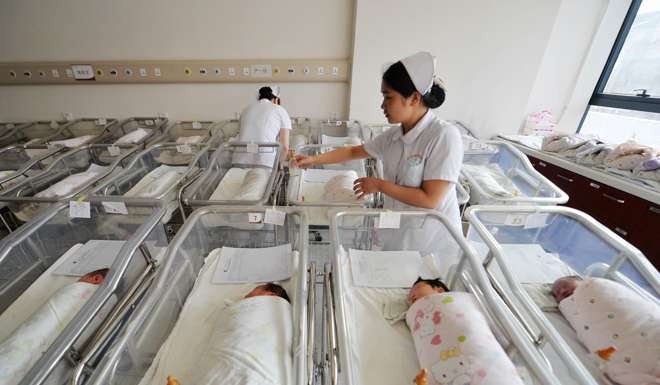
China’s government admits birthrate too low after decades imposing one-child policy
China’s birthrate is too low and needs to rise as the nation faces serious challenges including a shrinking labour force and rapidly ageing population, the government said in blueprint outlining population policies up to 2030.
The State Council proposed measures ranging from taxation incentives to introducing paternity leave to boost birth rate, but demographic experts said the cost would be huge.
The proposals were raised in a population planning document released on late Wednesday. The document came after authorities relaxed the one-child policy over a year ago to allow couples to have two babies.
The relaxation of the policy, which was described by critics as brutal, helped drive up the number of births to 18.46 million last year, the biggest annual increase since 2000, according to China’s family planning commission.
But the number fell short of previous expectations of at least 20 million new babies under the two-child policy.
The State Council paper admitted that China’s birthrate, which has been dipping below “replacement level", would continue to stay low in the long-term even after the launch of the two-child policy.
Families remain reluctant to have a second child for various reasons. Many couples have previously said they were wary of having a bigger family because of the costs involved.
China is facing “relatively large pressure” in achieving an appropriate fertility rate, according to the government document.
The world’s most populous country will see its population peak at about 1.45 billion in around 2030, the document said. Its aging workforce aged between 45 and 69 will account for over one third of the population at that time, it added.
The number of people aged 60 or above will be increased to a quarter from 16 per cent in 2015.
“Population growth will slow down because of a falling number of women of childbearing age and the rising death rate in the elderly population,” the document said.
The prediction is based upon the hope that China's fertility rate, or the average number of children a woman gives birth to, will increase to 1.8 in the decade from 2020 to 2030, from a rate of 1.5 in 2015.
To keep the population size from shrinking over the long run, the fertility rate needs to stay above 2.1.
China started to implement its notorious one-child policy in the early 1980s and adopted brutal measures, such as forced abortions, to keep a lid on population growth.
The one-child policy was relaxed for some families in 2013 and then scrapped in 2015.
While the government said it would stick to the two-child policy for now, it will adopt measures to encourage families to have more babies through “taxation, child raising, education, social security and housing”, the report said. It did not specify details of the proposals.

By 2020, 89,000 new hospital beds as well as 140,000 maternity health workers would be ready for the pregnant women, it said.
Huang Wenzheng, a biostatistics expert at Johns Hopkins University who study mainland’s population policies, said the proposed measures would have “some effects” but the cost would be huge.
“Governments in Europe need to spend a lot of money to help encouraging families to have more babies, for example, by providing free education,” Huang said. “That would mean five to six percent of GDP, which in China, would be higher than military spending.”
Huang predicted that as the number of new birth in China would begin to fall in 2018, the population peak would come earlier, at around 2022 and 2023, China should completely scrap the birth control.

